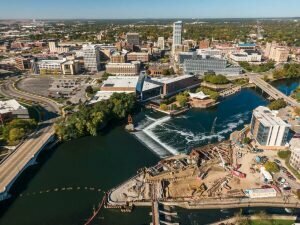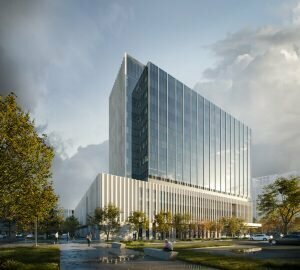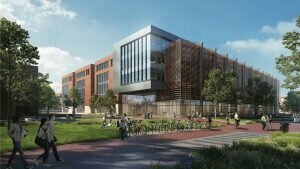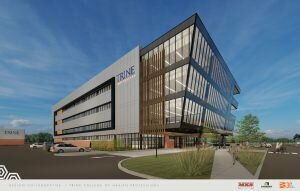There’s a whole lot happening in college construction these days. For this rundown of some of the biggest developments, we’re taking a look at projects that were specifically established to meet and adapt to long-term needs.
This is an interesting period of growth for academia in Indiana – things are changing. Pathways of study have been evolving and the specific infrastructure needs of facilities themselves have been changing. So, Hoosier colleges have been rising to the challenge by designing projects that can both educate and support education for decades to come.
Notre Dame’s Hydroelectric Plant, $27.1M
The University of Notre Dame’s $27.1 million hydroelectric plant project, named ND Hydro, has concluded after several years of work and planning. The new instillation sits inside of a dam on the St. Joseph River in downtown South Bend.
The waters of the St. Joseph River are going to be moving underground turbines that generate electricity, which is then transmitted to the campus. Officials estimate the new 2.5-megawatt plant will produce about 7% of the university’s electrical needs. That will offset about 9,700 tons of carbon dioxide annually and help Notre Dame meet its sustainability goal to cut its carbon emissions in half by 2030 and completely by 2050.
Rieth-Riley Construction and Ozinga officials said that one of the project’s major challenges was finding the right concrete mix-design that would be durable enough to withstand the power of the river. The two firms developed an innovative mix that would not only be strong enough but would also meet strict temperature, strength, and cost requirements. Construction involved more than 6,700 cubic yards of poured and precast concrete, plus 1.1 million pounds of steel.
 Image from Ozinga.
Image from Ozinga.IU School of Medicine’s Medical Education Building, $175M
Construction is underway on the massive new Medical Education Building for the IU School of Medicine that will be located not far from IUPUI’s campus. Due to be complete in the latter months of 2024, the project will establish a new 323,000-square-foot medical education facility. The 11-story building will be co-located with the Indianapolis Academic Health Center that’s in development by IU Health, which will be part of the university’s new medical campus.
Everything about the new facility will be designed with forward-thinking growth in mind. For example, about 77,000 gross square feet of shell space is going to be available for any future for research needs.
University officials have described the building as a three-story base structure with a basement and an eight-story tower atop the southern portion. The base structure will focus primarily on medical education, with support spaces, shell space, academic learning spaces that will include 12 small learning communities, classrooms, a medical library, and a central space for gathering.
The eight-story tower will be used for offices and research. Three floors will be faculty offices, three will be shell space that’s planned for modular biomedical research and other offices, and two full floors will be for mechanical purposes.
 Image from IU.
Image from IU.Purdue’s Gateway Complex, $140M
A brand-new state-of-the-art Gateway Complex recently opened at Purdue University’s West Lafayette campus. The $140 million location consists of two connected buildings named Dudley Hall and Lambertus Hall that together total about 251,000 square feet. Inside sits the new homes for the Purdue Polytechnic Institute and the College of Engineering, packed with lots of laboratory and instructional space.
New laboratories have been established for Purdue Polytechnic’s School of Construction Management Technology, School of Engineering Technology, Department of Computer and Information Technology, and Department of Computer Graphics Technology. There are also faculty offices and dedicated space for active learning and lab-centric instructional methods, most of which were previously geographically separated on campus.
According to the project’s architects, the labs inside the facility were not designed to accommodate single research teams, but instead were created to integrate students across an entire enterprise. This lets the students experience a full range of project challenges.
Dudley Hall comprises about 145,000 square feet of space and Lambertus Hall has about 110,000 square feet space. The new complex replaces the single-story Nuclear Engineering Building and Michael Golden Labs facilities and wraps around the west and south sides of the Knoy Hall of Technology.
 Image from Purdue.
Image from Purdue.Trine and Parkview’s New Health Building, $40M
Parkview Health and Trine University are partnering up on a new $40 million, 120,000-square-foot academic facility in Allen County that will house programs from the university’s College of Health Professions (CHP). The building will be a four-story facility designated as Trine University Fort Wayne, and officials expect it will open in Fall of 2024.
Once fully operational, Trine Fort Wayne will employ 100 faculty and staff and serve nearly 700 students from various CHP programs. This will include disciplines such as physical therapy, physician assistant, speech-language pathology, nursing, and surgical technology. CHP is also looking to add new programs, like occupational therapy, respiratory therapy, medical science, and emergency medical sciences.
The new building will feature state-of-the-art classrooms and laboratories, a Simulated Patient Care Center (SimCenter) that will including mock surgery and Emergency Room suites, and other exam and patient rooms. The building also will contain resources for student support, including a library, bookstore, gathering area, academic support, and counseling services.
Trine reported that demand for healthcare workers in the surrounding area is only projected to increase as our population ages. National BLS data projects a 31% job growth rate for physician assistants and 21% job growth for physical therapists by 2030.
 Image from Trine.
Image from Trine.